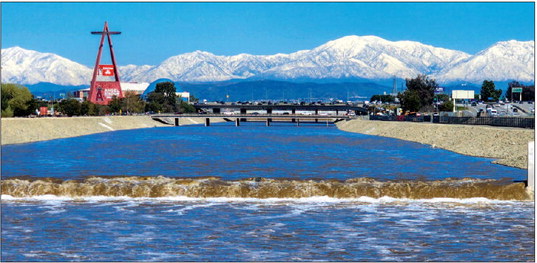LW water rates could increase by 33%


SEAL BEACH CITY COUNCIL
by Emma DiMaggio
Communications Manager
Leisure World residents may soon see increased water bills, triggered by inflation, debt payments, reduced water revenues, rising capital costs and inflation.
On Thursday, Feb. 26, the Seal Beach City Council will continue its public hearing on the proposed rate increase for the city’s water and wastewater services. The council is expected to decide whether to increase rates following the hearing.
Under the current proposal, the city would gradually increase water rates annually for the next four years.
What rate increases mean for LWers’ wallets Leisure World is unique in that, rather than having multiple water meters, the entire community is served by a single 6-inch meter—for reference, this is six times larger than the most common residential meter in Seal Beach.
Leisure World pays its water bill by dividing the cost of the bill by the number of units in the community, 6,608, and then distributing the cost on a Mutual- by-Mutual basis corresponding to each Mutual’s number of units.
Over the past 12 months, LW residents have paid an average $17.07 for water each month, according to data from the GRF Finance Department.
In comparison, the average residential unit in Seal Beach pays $55.76 per month, according to City of Seal Beach data.
If the proposed rate increases are approved, the cost of water in Seal Beach would increase by 33% in 2024—increasing LWers’ average monthly water bills to $22.70 per month.
At proposed rates, LW residents’ monthly water cost would increase 140% over the next four years, with an average monthly cost of $40.96 by 2028.
“The proposed water and sewer rates are not insignificant by any means,” Pub
Storm water flows on the Santa Ana River, which the Orange County Water District captures to recharge the groundwater basin. The City of Seal Beach gets at least 80% of its water from groundwater provided by the district.
Orange County Water District lic Works Director Iris Lee said at the Feb. 12 council meeting. “However, we need to look at it holistically, system-wide, and as impactful as it may be, the responsible thing is to make sure that we do not compromise health and safety.”
Inflation, debt payments, reduced revenue, capital costs and inflation cited as causes for increased rates During a Feb. 12 presentation to the council, Project Manager Steve Gagnon cited a variety of reasons for the proposed increases.
The first is the city’s debt. The City of Seal Beach currently has five loans, two of which are for water, and two of which are for wastewater utilities, Gagnon said at the meeting. He explained that when cities take on debt, they agree to a covenant— a pledge to bondholders that they’ll pay back their debt, plus some. In this case, the city pledged to recover 1.2 times its expenses, but it’s only recovering a portion of that amount.
Meanwhile, the city’s water and sewage infrastructure require substantial capital improvements. In some places, such as Old Town, areas of pipe were installed between 1900 and 1910.
“We all know they won’t last forever,” Gagnon said.
The proposed increases assume that the city will take on more debt to pay for these capital improvements, in the hope that spreading the costs across 30 years will help soften the blow for ratepayers.
“If [the city] doesn’t take on more debt, that means [the city] would have to cash fund the [proposed] capital projects,” Gagnon said, “which means rates would have to go up even more than what we’re proposing.”
Old pipes aren’t the only reason for the proposed increase. Two years ago, California’s ongoing drought led the state to move forward with initiatives encouraging people to conserve water. A year later, the state had one of the wettest years on record, and lawn watering decreased.
Both drought events and wet years result in the same effect: people use less water, and the city’s revenue decreases.Gagnon estimates that decreased water use resulted in a $600,000 loss in the city’s revenue.
The impacts of reduced water use were exacerbated by rising costs at the water’s source: the Orange County Water District (OCWD). The City of Seal Beach gets 80% or more of its water from groundwater, according to Gagnon, and the agency that replenishes that water, the OCWD, must now construct systems to treat groundwater for PFAs, commonly known as “forever chemicals.” As a result, the district’s water rates have increased beyond what the city predicted.
These are just a few of the constellation of factors that affect water rates, including population size, water sources, pipe age, historical investment, property tax revenue and elevation.
“Some people may feel there may be fluff that we can cut, but I can assure you, as this particular water and sewer system’s expert, we already did that,” Lee said. “We’re presenting you with the most responsible, efficient and effective option that there is.”
Seal Beach isn’t alone in its proposed hikes In Orange County, the two water districts serving Costa Mesa and Lake Forest have both raised rates due to a combination of inflation, rising capital costs and increasing rates from OCWD.
Huntington Beach, Pasadena and Burbank are all considering hikes as well. Nearly all are facing 10-33% increases, with Pasadena’s draft plan proposing a 152% increase in wastewater fees.
“Water and wastewater services are not like your typical government services, they’re not like police, fire, parks and recreation that are funded by tax dollars,” Gagnon said. “The goal is to simply cover your costs. You have to cover your costs, and you have to maintain reserves. That’s what we’ve tried to do in these financial plans.”
Proposition 218 states that revenues cannot exceed the funds required to provide the services; cannot be used to pay for anything other than the service for which it was charged; and the amount of the fee cannot exceed the proportion cost of providing service.
If the city can’t increase revenue to pay for the water system, the cost will impact the city’s General Fund—causing “major cuts in your essential services,” according to Lee.
The next public hearing on water rates will be held on Monday, Feb. 26, in the Seal Beach City Council Chambers at 211 Eigth St., Seal Beach, at 7 p.m. The televised meetings can be viewed on cable television on channel 3 or on the city’s website at https://www.sealbeachca.gov/ Government/ Agendas- Notices- Meeting-Videos.
Members of the public may speak at meetings during public comments or on any item listed on the council agenda. More information about the proposed rates is available at https:// www. 2023utilityratestudy. sealbeachca.gov/.
The City of Seal Beach is proposing a rate increase that could cost LWers an additional $5.63 per month in the first year.
Seal Beach City Council meetings are streamed live on cable, SBTV-channel 3, and on YouTube.
The Orange County Water District (OCWD) collects storm water to replenish its ground water. Rising prices at the OCWD may be passed down to LW residents.
Orange County Water District




